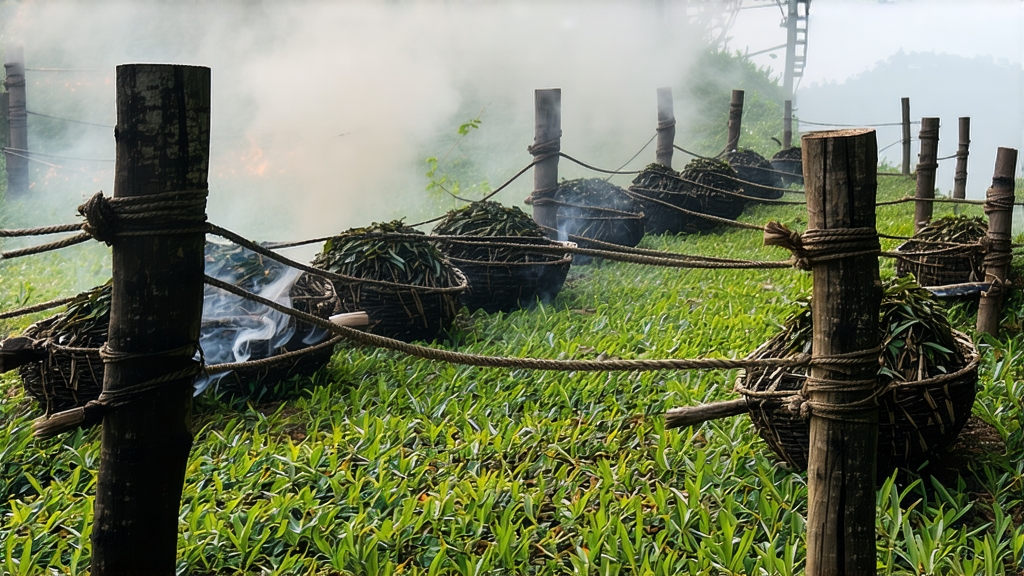
When European tea clippers first rounded the Cape of Good Hope in the late seventeenth century, the cargo that most excited London merchants was not green tea or porcelain, but a dark, slender leaf from the Wuyi massif in northern Fujian. They called it “bohea,” a corruption of the local place-name Wuyi; we now call the style black tea. At the heart of that original shipment sat the world’s earliest fully oxidised tea—Lapsang Souchong—still produced today in the same narrow, mist-locked valleys where pine and cedar outnumber people. Understanding this single tea is to hold a key to the entire genealogy of black tea, from Assam to Ceylon to the Keemun that would later enchant Queen Victoria.
History: From Mountain Hermitage to Global Commodity
Local legend traces Lapsang Souchong to 1568, when a passing army requisitioned the drying sheds of Xingcun village. To hasten the process, monks threw fresh leaves over smouldering pine boughs; the smoke impregnated the leaf, creating an entirely new flavour. Whatever the myth’s accuracy, by 1604 Dutch traders were auctioning “smoky bohea” in Amsterdam for prices higher than silver. The East India Company formalised the trade in 1669, and for the next two centuries Fujian’s pine-smoked leaf defined what “black tea” meant to the West. When the British later transplanted tea to India and Sri Lanka, they carried Lapsang Souchong cuttings and withering techniques; even today, many Indian estate managers refer to the “souchong” grade—the fourth leaf down the stem—as a nod to that heritage.
Micro-Terroirs within 60 km²
Authentic Lapsang Souchong comes only from the 1,200–1,800 m band inside Wuyi’s national reserve, an area smaller than Manhattan. Within this radius, three micro-zones are recognised:
• Tongmu Guan (桐木关): the highest and most sought-after, where nightly temperature inversions trap cool air, slowing oxidation and concentrating amino acids.
• Miaowan (庙湾): slightly lower, yielding a sweeter, less resinous cup.
• Dazhulan (大竹岚): the outer limit, where leaves absorb more bamboo and camphor accents from surrounding forest.
Leaves picked before Qingming (early April) fetch prices above silver because the reserve’s insect population is still dormant, allowing pesticide-free cultivation.
Craft: Smoke as Seasoning, Not Mask
The traditional craft unfolds over 18 hours without a single thermometer or electric fan. After plucking one bud and the first two leaves, the tea is withered on bamboo screens set 2 m above slow-burning pine embers. The smoke must be cool (28–32 °C) and resin-rich; resinous Pinus massoniana logs are soaked overnight to regulate smoulder rate. Every 20 minutes the leaves are gently turned by hand until they lose 60 % moisture and turn velvety to the touch.
Rolling follows, but unlike CTC (crush-tear-curl) methods used in Assam, Tongmu artisans apply only 8–10 kg of pressure for 45 minutes, preserving cell integrity so that smoke penetrates gradually. Oxidation occurs in pine-wood troughs lined with wet cloth; humidity stays above 85 % to encourage theaflavin formation while preventing the leaf from turning acrid. Finally, the tea is given a “second smoke” during firing: leaves are spread 3 cm deep over sieves while fresh pine branches are ignited below, then immediately extinguished to create white smoke. The entire process consumes one cubic metre of pine for every 2 kg of finished tea—an extravagance illegal outside the reserve, which is why authentic Tongmu Lapsang is never cheap.
Grades & Styles: From Pinewood to Fruitwood
Western supermarkets often sell a bluntly smoky “Lapsang” made with propane torches and artificial flavouring. The genuine leaf offers a spectrum:
- Traditional Pine-Smoked Souchong: ember-dried for 8 hours, tarry yet smooth, with notes of longan, dried prune, and campfire.
- Wuyi Smoked Zhengshan Xiaozhong: same leaf, lighter smoke (3 hours), allowing cocoa and malt to surface.
- Unsmoked